WAD, Wad, or wad may refer to:
WAD, Wad, or wad may refer to:
Link or Links may refer to:
VC may refer to:
Pit or PIT may refer to:

The Wii is a home video game console developed and marketed by Nintendo. It was released on November 19, 2006, in North America and in December 2006 for most other regions of the world. It is Nintendo's fifth major home game console, following the GameCube and is a seventh-generation console alongside Microsoft's Xbox 360 and Sony's PlayStation 3.
Doom WAD is the default format of package files for the video game Doom and its sequel Doom II: Hell on Earth, that contain sprites, levels, and game data. WAD stands for Where's All the Data? Immediately after its release in 1993, Doom attracted a sizeable following of players who created their own mods for WAD files—packages containing new levels or graphics—and played a vital part in spawning the mod-making culture which is now commonplace for first-person shooter games. Thousands of WADs have been created for Doom, ranging from single custom levels to full original games; most of these can be freely downloaded over the Internet. Several WADs have also been released commercially, and for some people the WAD-making hobby became a gateway to a professional career as a level designer.
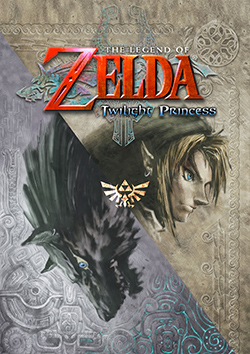
The Legend of Zelda: Twilight Princess is an action-adventure video game developed and published by Nintendo for the GameCube and Wii. Originally planned for release exclusively on the GameCube in November 2005, Twilight Princess was delayed by Nintendo to allow its developers to refine the game, add more content, and port it to the Wii. The Wii version was a launch game in North America in November 2006, and in Japan, Europe, and Australia the following month. The GameCube version was released in December 2006 as the final first-party game for the console.
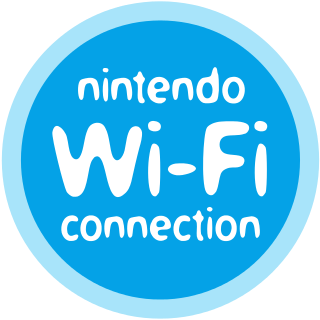
The Nintendo Wi-Fi Connection is a defunct online multiplayer gaming service run by Nintendo to provide free online play in compatible Nintendo DS and Wii games. The service included the company's Wii Shop Channel and DSi Shop game download services. It also ran features for the Wii and Nintendo DS systems.
iOS is a mobile operating system developed by Apple Inc.
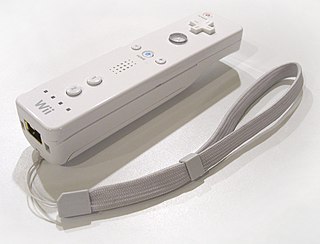
The Wii Remote, also known colloquially as the Wiimote, is the primary game controller for Nintendo's Wii home video game console. An essential capability of the Wii Remote is its motion sensing capability, which allows the user to interact with and manipulate items on screen via motion sensing, gesture recognition, and pointing which is used for the console, using accelerometer and optical sensor technology. It is expandable by adding attachments. The attachment bundled with the Wii console is the Nunchuk, which complements the Wii Remote by providing functions similar to those in gamepad controllers. Some other attachments include the Classic Controller, Wii Zapper, and the Wii Wheel, which has originally been used for the racing game, Mario Kart Wii.

Wii Music is a music video game developed and published by Nintendo for the Wii video game console. The game was released in Japan and North America in October 2008, and in Europe and Australia in the following month. Wii Music is part of both Nintendo's Touch! Generations brand and the Wii series.
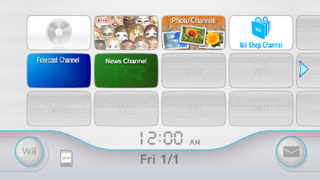
The Wii Menu is the graphical shell of the Wii and Wii U game console, as part of the Wii system software. It has four pages, each with a 4:3 grid, and each displaying the current time and date. Available applications, known as "channels", are displayed and can be navigated using the pointer capability of the Wii Remote. The grid is customizable; users can move channels among the menu's 48 customizable slots. By pressing the plus and minus buttons on the Wii Remote users can scroll across accessing empty slots.
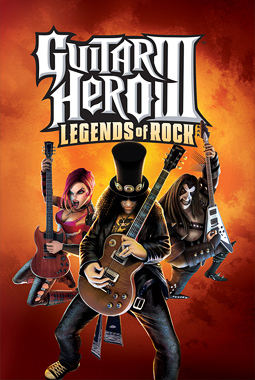
Guitar Hero III: Legends of Rock is a music rhythm video game developed by Neversoft and published by Activision. It is the third main installment in the Guitar Hero series, following Guitar Hero II. It is the first game in the series to be developed by Neversoft after Activision's acquisition of RedOctane and MTV Games' purchase of Harmonix, the previous development studio for the series. The game was released worldwide for the PlayStation 2, PlayStation 3, Wii and Xbox 360 in October 2007, with Budcat Creations assisting Neversoft on developing the PlayStation 2 port and Vicarious Visions solely developing on the Wii port respectively. Aspyr published the Microsoft Windows and Mac OS X versions of the game, releasing them later in 2007.

MadWorld is a beat 'em up hack and slash video game developed by PlatinumGames, published by Sega, produced by Atsushi Inaba, and directed by Shigenori Nishikawa. It was released worldwide for the Wii in March 2009, and in Japan in February 2010. Although a commercial failure, MadWorld received generally positive reviews from critics. A spiritual successor, Anarchy Reigns, was released in 2012 for the Xbox 360 and PlayStation 3.
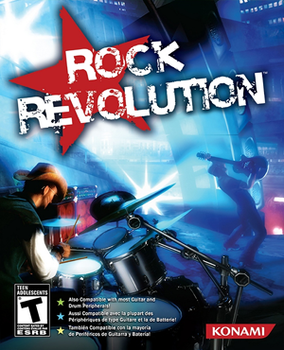
Rock Revolution is a music video game developed by Zoë Mode and HB Studios and published by Konami. The game was released on 15 October 2008 for the Nintendo DS, PlayStation 3, Wii and Xbox 360. As with similar titles, the game uses various controllers to simulate the performance of rock music, primarily using guitar and drum controllers on its Xbox 360 and PlayStation 3 versions.
Rock Band 2 is a 2008 music video game developed by Harmonix, published by MTV Games and distributed by Electronic Arts. It is the sequel to Rock Band and is the second title in the series. The game allows up to four players to simulate the performance of popular songs by playing with controllers modeled after musical instruments. Players can play the lead guitar, bass guitar, and drums parts to songs with "instrument controllers", as well as sing through a USB microphone. Players are scored on their ability to match scrolling musical "notes" while playing instruments, or by their ability to match the singer's pitch on vocals.

The Wii MotionPlus (Wiiモーションプラス) is an expansion device for the Wii Remote, the primary game controller for the Wii. The device allows more complex motion to be interpreted than the Wii Remote can do alone. Both the Wii and its successor, the Wii U, support the Wii MotionPlus accessory in games.

The Nintendo eShop is a digital distribution service for the Nintendo Switch, and formerly available via the Nintendo Network for the Wii U and Nintendo 3DS. The Nintendo eShop was first launched in June 2011 on the Nintendo 3DS via a system update that added the functionality to the HOME Menu. It is the successor to both the Wii Shop Channel and DSi Shop. Unlike on the Nintendo 3DS, the eShop was made available on the launch date of the Wii U, although a system update is required in order to access it. It is also a multitasking application, which means it is easily accessible even when a game is already running in the background through the system software, though this feature is exclusive to the Wii U and the Nintendo Switch. The Nintendo eShop features downloadable games, demos, applications, streaming videos, consumer rating feedback, and other information on upcoming game releases.
The Nintendo Network is Nintendo's online service which provides online functionality for the Nintendo 3DS and Wii U systems and their compatible games. Announced on January 26, 2012, at an investors' conference, it is Nintendo's second online service after Nintendo Wi-Fi Connection. Former president of Nintendo Satoru Iwata said, "Unlike Nintendo Wi-Fi Connection, which has been focused upon specific functionalities and concepts, we are aiming to establish a platform where various services available through the network for our consumers shall be connected via Nintendo Network service so that the company can make comprehensive proposals to consumers."